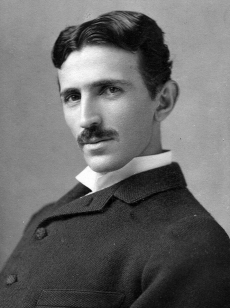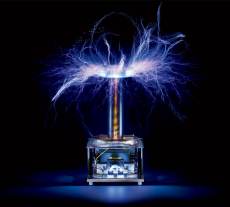
There are many great minds, which everyone learns about. Steven Hawking, Albert Einstein, Steve Jobs. But, there is one genius that lived throughout the later part of the 19th Century, and early 20th, who is strangely unknown to many. Nikola Tesla, whose inventions can be linked to safe, affordable electricity, radio, and hydroelectric power, as well as robots, x-ray photography, electric generators, spark plugs, remote controls, and florescent lighting. Having over 700 patents in his name, and speaking 8 languages, Nikola Tesla was undoubtedly one of the greatest minds of history, and, although certainly delusional, is definitely responsible for the technology that we are able to enjoy today.
Born in 1856, in what is now Croatia, Nikola Tesla had a normal childhood, though he himself was far from “normal”. As a child he attempted to create an umbrella-based glider, breaking his arm when testing out the prototype by jumping from the church roof. He also designed an insect-powered engine, which was foiled by his friend eating the June bugs he had captured, and also tried to create electricity by rubbing the family cats together. At age 17, Tesla was stricken with cholera, and, on his deathbed, begged his father to let him attend engineering college when he recovered. Tesla Sr. agreed, and, to his surprise, his son survived the disease.
In 1884, Tesla came to New York City, with only 4 cents, and a letter of introduction to the great American Inventor, Thomas Edison. Throughout the city, Edison’s DC current was being used as electrical power, which couldn’t maintain high voltage levels over long distance, meaning that there were incredibly dangerous power stations every 2 miles. Tesla, seeing this, explained to Edison his idea for alternating current, or AC, allowing a continuous, efficient movement of electricity over much greater distances. Edison scoffed at this idea, and, in response, assured Tesla he’d pay him $50,000 if he could achieve this modification. Sure enough, a few months later Tesla returned, with a fully functional prototype. When he asked Edison for his money, Edison insisted that Tesla ‘didn’t understand American humour’, and refused Tesla his money. After this meeting, the pair became mortal enemies. This seems like a slight exaggeration, but both refused to receive the Nobel Prize in Physics, each insisting they wouldn’t accept the award if the other received it first. Everyone knew there was no point in asking them to share. Though this seems a little petty, the depth of the feud can be understood from Tesla’s comment for Edison’s obituary: ‘He had no hobby, cared for no sort of amusement of any kind, and lived in utter disregard for the most elementary rules of hygiene’.

Later on in his life, Tesla became obsessed with wireless technology and communication. Discovering he could transmit and receive radio signals, Tesla was about to patent his new invention, when a fire in his lab destroyed the plans before he could reveal them. Another scientist, Marconi, was able to pioneer wireless technology a year later. A friend of Tesla informed him of the Italian’s invention, to which he replied: ‘Marconi is a good fellow, let him continue. He is already using seventeen of my patents’.
Near the end of his life, Tesla claimed to be building a 16 million volt death ray, which had the power to vaporise tanks, stating that it would ‘end all war’. Despite other ridiculous claims, such as receiving communication from extra-terrestrials, and being in love with a pigeon he had rescued from the street, Tesla was taken seriously by the U.S. government. After his death in 1843, at the age of 88, the FBI thoroughly investigated his workshop, and it was discovered that the death ray papers had disappeared.
Despite being now unknown by many, Nikola Tesla holds strong links to many modern inventions that we consider vital to our lives. It is interesting to note that he also wished to provide the world with free wireless energy, but never received the funding to complete his project. Although undoubtedly eccentric, Tesla deserves to be known not only for his outstanding intellect, but also for his contribution to the world that we now live in.
Images: http://www-tc.pbs.org/prod-media/newshour/photos/2013/07/10/Tesla_circa_1890_slideshow.jpeg
http://www.wired.com/magazine/wp-content/images/19-07/st_dangerous_teslacoil_f.jpg

0 Comment:
Be the first one to comment on this article.